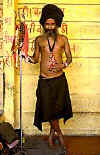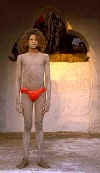|
|
||||
|
Role of
Internet In South Asian Development Technology
- a weapon to
Viewpoint Sundown Madness at Wagah Border
Heritage & Travel
Books
|
|
|
||
|
the-south-asian.com February 2001 |
||||
|
Page 2 of 4 by Dolf Hartsuiker
The Gorakhnathis or Jogis
Although in outlook very similar to the sannyasis, the Jogis do not follow the Vedantic teachings of Shankara, but adhere to the Tantric way taught by their Guru-founder Gorakhnath. Still, they are devotees of Shiva, albeit in his manifestation as Bhairava, and they worship Hanuman and Dattatreya. Gorakhnath, being an incarnation of Shiva, is worshipped as a deity by the Jogis, and has a number of temples dedicated to him. The Jogis are therefore often designated as 'Gorakhnathis', or more simply 'Nath-Babas'.
The Udasin Vital Das, an Udasin baba, his body covered with ash.The major sect of Udasin ascetics was originally not Shaiva -- nor even Hindu -- but belonged to the Sikh religion. It was founded in the sixteenth century by a son of Guru Nanak -- himself the founder of Sikhism -- called Shrichandra. The Udasin are therefore also known as Nanakputras, the 'sons of Nanak', and they revere the Grantha Saheb, the sacred book of the Sikhs. They were excommunicated by the successor of Guru Nanak and gradually turned to Hinduism. The Udasin worship panchayatana, a combination of five deities, namely Shiva, Vishnu, the Sun, goddess Durga, and Ganesh; moreover they worship their founder-Guru Shrichandra. Their philosophy is basically the monistic Vedanta as set forth by Shankara, and in other respects as well they closely resemble the Shaiva sannyasis. Like all Shaiva sannyasis, the Udasin usually wear red or black cloth, apply ashes, have long hair in jata, and so on, but differ in details such as their woollen knitted caps and a small silver crescent ring in the right ear. Furthermore, whenever they had to choose sides in fights with rivalling sects, they were on the side of the Shaivas.
The Aghoris
The Aghoris are a small sect. Their favourite haunt is the cremation-grounds; they bathe in cremation-ashes; and willingly transgress all ascetic (and Hindu) taboos, convinced as they are that by 'reversing all values' they will speed up enlightenment. While all sadhus are supposed to be vegetarian and teetotallers (like most Hindus for that matter), Aghoris eat meat and drink alcohol. Aghoris preferably live on cremation grounds and surround themselves with artifacts of death, like human skulls out of which they drink and with which they perform magical rituals. Nonetheless, the Aghoris represent a tradition that is thousands of years old, but their numbers have dwindled. |
||||
| Copyright © 2000 [the-south-asian.com]. Intellectual Property. All rights reserved. | ||||
| Home |


